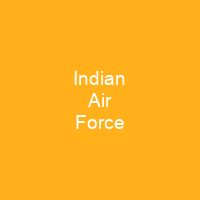The Indian Air Force is the air arm of the Indian Armed Forces. Its primary mission is to secure Indian airspace and to conduct aerial warfare during armed conflict. The IAF has been involved in four wars with neighbouring Pakistan and one with the People’s Republic of China. The President of India holds the rank of Supreme Commander of the IAF.
About Indian Air Force in brief

In 1945, King George VI conferred the prefix ‘Royal’ on IAF in recognition of the valiant service by IAF pilots. During World War II, IAF played an instrumental role in halting the advance of the Japanese army in Burma. It was referred to as the Royal Air Force after the transition to the Dominion of India in 1950. It is the fourth largest air force in the world, with a complement of personnel and aircraft assets that ranks fourth amongst the air forces of the world. It also provides close air support to the Indian Army troops on the battlefield as well as strategic and tactical airlift capabilities. It has also undertaken relief missions such as Operation Rainbow in Sri Lanka. In April 1933, the I AF commissioned its first squadron, No. 1 Squadron, with four Westland Wapiti biplanes and five Indian pilots. On 26 January 2002, Arjan Singh became the first and so far, only five-star rank officer of the IAF. He was the first Air Marshal of the air force to be awarded the title ‘Five Star Marshal’. He is the only Air Marshal to have ever been awarded the rank ‘five-star marshal’, which is the highest rank in Indian military history. The rank of Air Marshal has only been awarded on one occasion in history, to Arjan Singh in 2002, when he was appointed as the first five- star rank officer. The Air Force’s mission is defined by the Armed Forces Act of 1947, the Constitution of India, andthe Air Force Act of 1950.
You want to know more about Indian Air Force?
This page is based on the article Indian Air Force published in Wikipedia (as of Dec. 17, 2020) and was automatically summarized using artificial intelligence.







